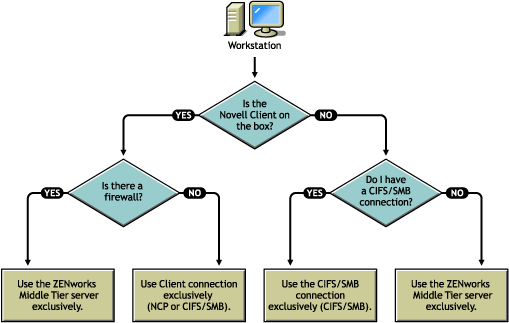What Is the ZENworks Multiple UNC Provider?
The Multiple UNC Provider (MUP) is a Windows service that assists in locating network resources identified using the Uniform Naming Convention (UNC). MUP receives commands containing UNC names from applications and sends the name to each registered UNC provider. When a provider identifies a UNC name as its own, MUP automatically redirects future instances of that name to that provider. Essentially, MUP determines which client the system must use to access the requested UNC name and hands off requests to that client's redirector. The redirector then directs the resource request from the workstation to the device on the network that can provide the resource.
The ZENworks Multiple UNC Provider (ZENMUP) lets workstations establish, on a per session basis, the fastest connection available to network policies and applications based on the customer's environment and what clients they are using. When requests for files (such as group policies, applications, and inventory requests) come from the ZENworks Desktop Management Agent, ZENMUP first attempts to access those files on the identified network volume by using any installed client (calling _access on the network volume to test for existence). If this succeeds, the file system provider registered with Windows claims this network name and native file system calls are used to access all files on that network volume. If no file system provider knows about that network name, the call fails and the ZENworks Middle Tier Server is used to access files on that volume. When the successful access method is determined, that information is stored in the Windows mup.sys file during that session. Subsequent file access to the same volume is accomplished with a lookup on that file.
ZENMUP is automatically installed and enabled as part of the ZENworks 6.5 Desktop Management Agent installation. It doesn't need to be configured and cannot be disabled.
How Does ZENMUP Work?
How ZENMUP works depends on the environment in which is it used, as outlined in the following diagram:

In a NetWare® server environment, when requests for files come from a workstation, ZENMUP first checks to see if the Novell Client is installed on the workstation. If it is installed, and if no firewall is present, the client will use either the NetWare Core ProtocolTM (NCPTM) or a CIFS/SMB connection to access the server, depending on the network operating system where the ZENworks files are stored.
IMPORTANT: Using ZENworks 6.5 with versions of the Novell Client prior to 4.9 SP2, a Middle Tier connection cannot be forced by right-clicking the Application Launcher/Explorer icon and selecting ZENworks Middle Tier Server Login (as it could be in ZENworks 4.0.1). Upgrading to Novell Client 4.9 SP2 allows a forced Middle Tier connection in ZENworks 6.5. If user logins hang, you can remove the ZENworks Middle Tier login option using the Launcher Configuration setting.
If ZENMUP detects that a firewall is present, all communication is done through the ZENworks Middle Tier Server.
If no firewall is present but CIFS is running on the NetWare servers, the NetWare server attaches a -w or _w (depending on the NetWare version) to the CIFS server name to differentiate the CIFS protocol from the NCP protocol, thereby avoiding conflicts. If resources are stored on a Windows server, those resources are accessed by the Microsoft client using a CIFS/SMB connection.
If the Novell Client is not installed on the workstation, ZENMUP checks to see if there is a CIFS/SMB connection. If there is, ZENMUP uses the CIFS/SMB connection exclusively. If there is no CIFS/SMB connection, ZENMUP uses the ZENworks Middle Tier Server to access the files.
User support inside a firewall (using CIFS only) and continual support when outside a firewall (using HTTP) requires that the Middle Tier Server's host file is configured to recognize the CIFS server name with the -w or _w.
Workstation support is limited to the Middle Tier Server. When configuring the file location, you must specify the server's NetBios name (NetWare machine name), thus forcing the connection to go through the Middle Tier Server.
In a Windows-only environment, you must use a domain controller, and each workstation must be a member of the domain. Inside the firewall, the MS Client (CIFS) is always used for connections. Outside the firewall, the Middle Tier Server is used. Because the CIFS/SMB protocol allows Guest authentication to a network volume (with no file rights required for workstations that are not in a Windows domain), all workstations in an agent-only environment must be members of a Windows domain. This allows ZENMUP to function as designed.
For each network name (server name or IP address), an entry is stored in the Windows mup.sys file telling ZENMUP which connection to use. After a connection has been made, it is saved and used for that session.
NOTE: If your authentication environment changes (for example, if your CIFS server was down during the first access attempt, then you subsequently start it), you must reboot the workstation to refresh the file entries.
ZENMUP is session-based, so any connections made during a session are released when the workstation is rebooted.
ZENMUP Environments
For a quick overview of how ZENMUP works in different environments, see the following table: